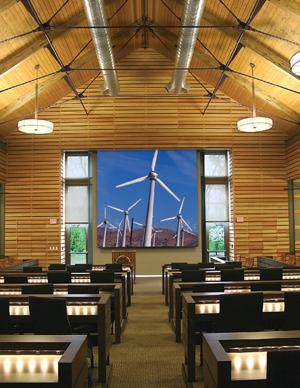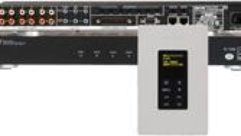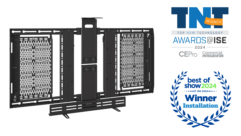

AV Attempts to Tread Lightly
Although there is growing demand for energy-efficient audio/video products, green AV is by no means a slam dunk.
EXTRA GREEN TO BE GREEN?MEASURING GREENNESSPLENTY OF GREEN TO GO AROUND
Draper shades and a screen with GreenGuard indoor air quality certified viewing surface hang in The Prindel Institute on the campus of Depauw University in Greencastle, Ind.
IT’S TOUGH TO GO A DAY WITHOUT HEARING “carbon footprint” or “green.” With those terms now firmly in the mainstream lexicon, some pro AV vendors and integrators see awareness as an emerging opportunity to differentiate their products and services.
Case in point: NEC Display Solutions is set to release a series of desktop displays that has a carbon footprint figure on the shipping box. The displays themselves have an on-screen calculator that shows how that footprint figure changes when the user adjusts settings such as brightness, which affects how much power is consumed.
“What we’re trying to educate people about is the fact that how bright they have their unit, their power management settings, all of these affect the environment,” says Kirt Yanke, director of product development at Itasca, Ill.–based NEC.
And judging by the requests for proposals (RFPs) that some integrators have been getting, there’s a growing market for green pro AV products, including those that are Restriction on Hazardous Substances (RoHS)-compliant.
“Many RFPs we’ve received in the past year or so have specifically requested that we select equipment that is RoHS-compliant or has some type of green program associated with the product,” says Glenn Polly, owner of VideoSonic, a New York–based integrator. “Both our corporate and university clients have adopted initiatives in which current and future purchase of goods or services comply with a green program of some type.”
As such end-user initiatives grow, green becomes more of a market-differentiation opportunity for vendors and integrators. Some say green could eventually become like information technology, in the sense that understanding the issues and being able to speak the lingo are key to building credibility in the eyes of potential clients.
“Green buildings are growing at a large rate, and part of the building process is communication among everyone,” says Clint Childress, green buildings coordinator at Spiceland, Ind.–based Draper. “This means that those able to speak and talk about green amongst the decision-makers on the project can play a larger role in it.”
Other vendors agree. “I would recommend gaining knowledge of the key green industry initiatives and specification requirements for each product category,” says Gene Ornstead, director of digital TV and business development at ViewSonic in Walnut, Calif. “These would include requirements like Energy Star (www.energystar.gov), RoHS, and Electronic Product Assessment Tool (www.epeat.net). Acquiring this knowledge would equip integrators to add value to their proposals.”
Green is a catchall term that covers everything from products that are highly energy-efficient to vendor programs that make it easy for integrators or end-users to recycle products that are at the end of their lifespan. But green could just as well describe the price premium that some of those products carry. A client’s willingness to pay a premium for green often depends on whether they believe they’ll see a return on investment.
“For example, if paying $500 extra for a product will get them only $100 over a few years, then you have some selling to do,” says Childress, LEED-AP. “If it is a green choice with little payback, paying extra is a hard sell.”
That acronym after Childress’ name indicates he’s an accredited professional under the U.S. Green Building Council’s Leadership in Energy and Environmental Design (LEED) program (www.usgbc.org/LEED)—its guidelines and benchmarks are influencing more and more pro AV projects. The more clients that are aware of LEED, the better the chance of convincing them to pay a premium for green products.
“Especially if they are a new construction or renovation project where the architect is compiling LEED credits, the client is willing to pay a little more for [products that comply with] Energy Star or other green programs,” says VideoSonic’s Polly.
One way to create a business case for using green products is by looking at more than just the amount of power they consume. For example, products that generate heat can increase the client’s total cost of ownership if it means spending more to cool a facility.
“ViewSonic does get questions from solution provider value added resellers [about whether] our products are environmentally friendly,” Ornstead says. “The most common questions are related to energy efficiency and how much heat is generated by the display or TV, which ties to concerns about overall energy consumption, including office air conditioning and electrical costs.”
In some verticals, green products and know-how are now must-haves. But so far, they’re the exception rather than the rule.
“For critical government and educational bids, vendors must satisfy the specification requirements surrounding green initiatives or the company will not be qualified to bid,” says Ornstead. “Unfortunately many other businesses are not as strict and typically purchase on price and functionality. They are rarely willing to choose a more environmentally friendly product if it costs more.”
Another way that vendors are accommodating integrator and end-user interest in green is by establishing recycling programs. ViewSonic offers a recycling program through partners such as AnythingIT and uses recycled plastics in new products.
“Draper and Da-Lite have old-screen recycling programs, and NEC will give a trade-in [credit] for older projectors if they are recycled through its program,” says VideoSonic’s Polly.
One catch in all this is that it can be difficult for end-users or integrators to make apples-to-apples comparisons among multiple vendors’ green products. That’s partly because figures such as power consumption can be massaged or calculated different ways from vendor to vendor.
“Everyone quotes a typical power consumption, which doesn’t have the same definition from every manufacturer,” says NEC’s Yanke.
Another challenge is that useful points of comparison, such as pixels per watt, often aren’t included on spec sheets. Whatever the culprit, the bottom line is that fair comparisons are not merely academic. The inability to draw them can affect an integrator’s chances of making a case for using one green product over another.
“If the product draws power, compare it with other models and ask how much power it draws in sleep mode,” Childress says. “This can be difficult, but if pressure is put on manufacturers to supply certain information in certain ways, it will happen.”
Apples-to-apples comparisons also might get easier because industry groups and government agencies are developing new criteria. “We’re currently working with the EPA on a future standard that will take into consideration large displays and the technology used in them,” says Yanke. “They’re trying to determine what the power-saving-mode numbers should be.”
For vendors, the ability to meet demand for green products depends partly on their suppliers. It’s here that consumer interest in green AV products can be helpful, simply because the consumer market is so large and thus drives the volume necessary to convince suppliers to go green.
An example: A plastics manufacturer develops a product that’s biodegradable or that uses chemicals that have minimal environmental impact—all because the consumer AV vendors that the manufacturer sells to are increasingly demanding them. Pro vendors can use those plastics, too.
Another market driver is the RoHS regulations, which are now in effect in major markets such as China and the European Union. Consumer and pro AV vendors that sell into those markets have to go green to some extent in order to have RoHS-compliant products. So between RoHS and consumer AV’s interest in green, pro AV vendors say they have a good and growing selection of green components and raw materials.
“All of the suppliers for every component are starting to get on the green bus,” says NEC’s Yanke.
One example is the way that some backlight suppliers are redesigning their products from the traditional straight shape into U-shaped bulbs. That design cuts the bulb count—and in the process, the amount of mercury in a display—by about half. It also reduces the amount of power consumed, all with what some display vendors say is no trade-off in brightness.
“It’s a big advantage for customers because they get the same specifications and don’t see a difference, but on the back side, we’re saving them a lot of money and also saving the environment,” Yanke says.
Tim Kridel is a freelance writer and analyst who covers telecom and technology based in Columbia, Mo. He can be reached at [email protected].










